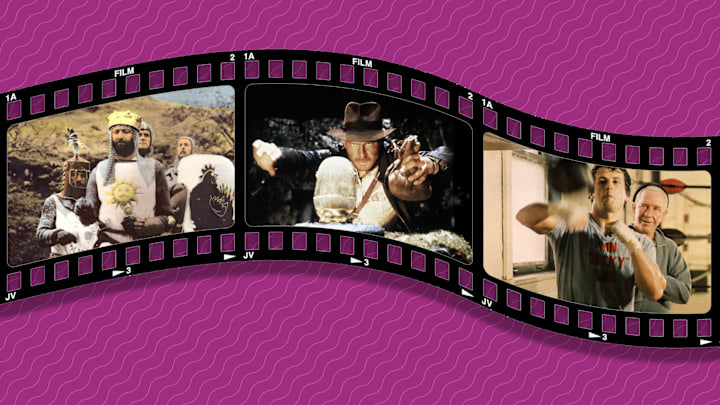You might expect budget limitations to result in mediocre films—and that certainly happens. Christopher Reeve regretted making the low-budget Superman IV: The Quest for Peace (1987), describing the movie as a “catastrophe from start to finish” that dealt “a huge blow to my career.”
But budget constraints aren’t always bad news for a film. Sometimes, filmmakers find creative solutions to financial limitations that make the movie better than it would have been with unlimited cash. Check out how these movies were all improved by budget constraints.
- Night of the Living Dead (1968)
- Monty Python and the Holy Grail (1975)
- Rocky (1976)
- Raiders of the Lost Ark (1981)
- The Lost Boys (1987)
- Deadpool (2016)
Night of the Living Dead (1968)
George Romero made Night of the Living Dead independently on a tiny budget of $114,000, which meant nearly all of his directorial choices were based on cost.
He cast unknown actors, chose abandoned buildings for filming locations, and used Bosco’s chocolate syrup and ham from a local butcher to simulate blood and guts. And to cover up any imperfections of the frugal production, Romero used 35mm black-and-white film for the actual cinematography.
The choice to film in black-and-white helped make Living Dead a classic. Black-and-white film not only made Romero’s low-cost special effects look more realistic, but it also gave audiences the sense they were watching a newsreel or documentary, which only added to the terror.
Monty Python and the Holy Grail (1975)
Monty Python and the Holy Grail opens with the sound of distant hoofbeats echoing through a thick fog. But when King Arthur (Graham Chapman) appears, the audience sees he’s not actually on horseback, but simply skipping along while his servant Patsy (Terry Gilliam) knocks together two coconut shells to mimic the sound of a galloping horse.
Originally, the Pythons intended to have Arthur and his knights ride on horseback—but the production couldn’t afford real horses. Recalling that coconut shells were traditionally used on radio shows to emulate the sound of horses, they realized it would be an even funnier way for Arthur to ride horseback.
Not only did the coconut shell solution solve their immediate budgetary problem, but John Cleese has said that the decision to use coconuts also helped them to “realize the possibility of medieval comedy.”
You Might Also Like ...
- 7 Movies That Changed the World in Surprising Ways
- Quiz: Can You Match the Fictional Place to the Movie?
- 15 Actors Who Refuse to Watch Their Own Movies
Add Mental Floss as a preferred news source!
Rocky (1976)
When Rocky Balboa (Sylvester Stallone) takes Adrian Pennino (Talia Shire) ice skating in the deserted rink on Thanksgiving, the pair enjoys a sweet conversation while Adrian skates and the boxer jogs beside her. It’s one of the most memorable scenes in the entire Rocky franchise.
But the original scene called for 300 extras, which the production couldn’t afford. Stallone arrived at the shooting location and only found a single extra instead of hundreds, so he had to quickly rewrite the scene.
His rewrite made for a much more intimate and character-driven scene. The audience gets to see how Rocky is willing to go the distance for his girlfriend, and the empty ice rink seems like a more natural place for the shy Adrian to open up than a crowded one would have been.
Raiders of the Lost Ark (1981)
Paramount greenlit Raiders of the Lost Ark with the understanding that producer George Lucas and director Steven Spielberg would pay steep fines if the production ran long or went over budget. Spielberg storyboarded the entire film, including action sequences and dialogue-heavy scenes, to ensure things would run smoothly.
Unfortunately, Harrison Ford (along with much of the rest of the cast and crew) succumbed to food poisoning in Tunisia during filming, which threatened to upset the schedule and budget. So when someone suggested Indy shoot the sword wielding bad guy instead of engaging in the elaborate whip-and-blade fight that had been storyboarded, the film got an iconic and funny scene, production ended early, and Ford got to rest.
The Lost Boys (1987)
Working with a limited budget of $8.5 million, director Joel Schumacher did not have enough money for the elaborate special effects necessary to make Jason Patric, Kiefer Sutherland, and his other teen vampires fly in The Lost Boys.
So Schumacher took a page from Jaws and instead used POV camera shots to indicate that the airborne undead were out for blood. The result was more effective, scarier, and much less likely to look like an outdated effect after just a few years.
Deadpool (2016)
The average film in the Marvel Cinematic Universe has a production budget of over $190 million, while Deadpool (2016) was made on a budget of $58 million.
But that’s not the only reason why Ryan Reynolds’s Wade Wilson regularly breaks the fourth wall to rag on 20th Century Fox for not having enough money to pay for special effects. The studio also slashed $7 million from the original production budget of $65 million just 48 hours before giving the official greenlight.
Screenwriters Rhett Reese and Paul Wernick had to cut several scenes, characters, and action sequences from the script to meet the new budget. But the cuts led to a leaner script with funnier and more character-driven scenes.
Specifically, Deadpool’s final confrontation with Ajax was originally scripted as a huge gun fight. Without the budget for that action scene, Reese and Wernick had Deadpool forget his guns in the cab to avoid the expensive effects. It made the finale hilarious and fitting for Deadpool.
